Gloucestershire Warwickshire Railway
| Gloucestershire Warwickshire Railway | |
|---|---|
| The Honeybourne Line | |
 | |
| Toddington railway station, August 2007 | |
| Locale |
Gloucestershire, Worcestershire England |
| Terminus |
Cheltenham Racecourse and Laverton Halt |
| Commercial operations | |
| Name | The Honeybourne Line |
| Built by | Great Western Railway |
| Original gauge | 4 ft 8 1⁄2 in (1,435 mm) standard gauge |
| Preserved operations | |
| Operated by | Gloucestershire Warwickshire Steam Railway Plc |
| Stations | 5 |
| Length | 12 miles (19 km) |
| Preserved gauge | 4 ft 8 1⁄2 in (1,435 mm) standard gauge |
| Commercial history | |
| Opened | 1906 |
| Closed | 1976 |
| Preservation history | |
| 1981 | Gloucestershire Warwickshire Steam Railway Plc formed and track re-laying began |
| 1984 | First public service along relaid section of track between Toddington Station and (the site of) Hayles Abbey Halt |
| 1987 | GWR Extended to Winchcombe |
| 1997 | GWR Extended to (the site of) Gretton halt |
| 2000 | Extended to Gotherington |
| 2003 | Extended to Cheltenham Racecourse |
| 2011 | GWR extends to (the site of) Laverton halt |
| Headquarters | Toddington, Gloucestershire |
The Gloucestershire Warwickshire Steam Railway (GWR, GWSR or Gloucs-Warks Steam Railway) is a volunteer-run heritage railway which runs along the Gloucestershire/Worcestershire border of the Cotswolds, in the West Midlands, England.
The GWSR has restored and reopened 12 miles (19 km) of line, operating between Cheltenham Racecourse and the site of Laverton Halt. The company is currently raising £1.5 million to extend 3 miles (4.8 km) northwards to Broadway, and will eventually begin working on plans to extend a further 6 miles (9.7 km) to Honeybourne, (where one half of an island platform has since been left unrebuilt for their future usage).
Overview
The line was originally part of the Great Western Railway's Cheltenham–Stratford-upon-Avon–Birmingham line, known as the Honeybourne Line, built in 1900–1906, and runs through the Cotswold towns of Winchcombe and Bishop's Cleeve.[2] The line was run down over the years and finally closed after a derailment damaged a stretch of track in 1976, with the double track being lifted from 1979.
The preservation group rehabilitated the line, starting steam train operations at Toddington in 1984 over 700 yards (640 m) of re-laid track. In 1987 the line was restored as far as Winchcombe where the station was reconstructed using the former Monmouth Troy station building. The railway continued to re-lay track west of Winchcombe, through the 693-yard (634 m) long Greet Tunnel, and past the villages of Gretton, Gotherington and Bishops Cleeve.[3] This culminated in the reopening of the line to Cheltenham Racecourse in 2003, by Princess Anne.
The GWSR runs trains from March to the end of December,[4] with the line closing during January and February as well as November for line and locomotive maintenance. The GWSR runs regular train services every weekend plus most weekdays from Easter to the end of October, and some weekends are used to host special events including steam and diesel galas, Day out with Thomas events and Santa Specials.
The railway operates a wide variety of both steam and heritage diesel locomotives, as well as heritage DMUs. These have included the world-famous locomotive 4472 "Flying Scotsman" and equally famous 3440 "City of Truro", which in 1904 was the first engine to reach 100 mph. In 2016 the resident steam locomotives on the line were 7820 "Dinmore Manor", 28xx class 2807, 42xx class 4270, 7903 "Foremarke Hall" and 35006 "Peninsular & Oriental SN Co". To complement the running stock a collection of over 210 carriages and wagons of various origins has been compiled, many of which are still being restored.
Signalling of the Heritage GWSR
The route consists of single line sections with passing places at the major stations. All stations and loops are signalled using GWR Lower Quadrant Semaphore Signals.[5][6]
The signalling on the line is a mixture of Electric Key Token and One Train Staff working, depending on operational requirements. Current sections are:
- Laverton–Toddington (One Train Staff)
- Toddington–Winchcombe (EKT)
- Winchcombe-Gotherington (EKT)
- Gotherington-Cheltenham Race Course (EKT)
- Winchcombe–Cheltenham Race Course (EKT) (With Gotherington switched out)
- Toddington–Cheltenham Race Course (One Train Staff - with Winchcombe and Gotherington switched out and Cheltenham Race Course behaving as a ground frame)
There are four signal boxes on the line, and a new platform mounted one at Broadway is under construction, with the frame parts all acquired and assembled:
- Broadway – under construction
- Toddingon – operational
- Winchcombe – operational
- Gotherington – operational
- Cheltenham Racecourse – operational
Future development plans
North to Broadway
Major works are focused on raising funds to extend northwards to Broadway by 2018. After receiving planning permission for the reconstruction of Broadway station to a similar plan to the previously demolished original, construction of both platforms is complete (Autumn 2016), with signal box construction complete but lever frame not yet operational (Autumn 2016). In late 2016 the main station building is complete to window level. In early November 2016 new track has been laid to within 200 yds of Peasebrook Farm thanks to the latest share offer.[7] The railway is currently engaged in raising £1.25 million in a share offer entitled "Broadway: the last mile" which aims to complete the extension and have it operational.
Hayles Abbey Halt
On a smaller scale, a band of volunteers are rebuilding the small halt that served Hailes Abbey.[8] Like quite a few other GWR stations, the Great Western decided on their own way of spelling the name. Although using modern construction methods, the halt will be finished to look as much like the original halt as possible.
South to Cheltenham
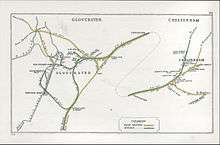
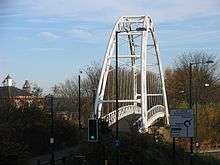
Encouraged by support from Cheltenham Borough Council, who have given both the railway direct funds as well as placing protected status on the former lines trackbed south from Cheltenham Racecourse to Cheltenham Spa, the railway could at some point connect to Network Rail in the south.
The Council have backed the long term scheme, as this would allow the railway to:
- be reinstated as an access point for race goers from all across the UK to easily access meetings at Cheltenham Racecourse, and reduce resultant current traffic congestion[9]
- build a new station at Cheltenham North, to serve a nearby sports stadium
- run tourist and excursion trains to access the railway and the town
- run a possible future cross-city commuter route, from the Racecourse to Cheltenham and possibly onwards to Gloucester
Although the GWSR has extended track to Hunting Butts tunnel, a few hundred metres beyond Cheltenham racecourse station, it owns the trackbed as far as the Prince of Wales stadium at Wyman's Brook. It is likely that after extending to Broadway laying track further into Cheltenham will happen to this point; a distance of about 1 mile. However, beyond here major and costly engineering works would be required to extend the trackbed further south.
The primary impediment is a bowstring bridge (located at 51°54′09″N 2°05′11″W / 51.90245°N 2.086434°W), built in 2002 to allow continued access by bicycle along the old track bed alignment to Cheltenham Leisure Centre. When planning permission was given for the redevelopment of the former Cheltenham Spa St. James station site as a Waitrose supermarket in 2002,[10] a condition was imposed that the developer construct a new pedestrian bridge to ensure continued access to the remaining trackbed.[11] The resulting bowstring bridge follows a section of former railway embankment, which was removed to provide road access to the new store.[12]
Landslips
In the early 2010s the GWSR was affected by two major landslips in embankments on the line, which cut it into separate sections; however, both slips have now been repaired, and the line has been fully re-opened.
2010 (Gotherington)
In April 2010 the GWSR suffered a landslip of an embankment near Gotherington.[13] Train services continued despite the Gotherington landslip, but over a reduced route. The landslip forced the closure of the line south of Gotherington, including Cheltenham Racecourse Station, which was effectively cut off. The railway continued to operate services from Toddington to Gotherington, with a locomotive at both ends of the train ("top and tailed"), as it was not possible to run the locomotive around the train at Gotherington at the time (there is now a run round loop just south of Gotherington). The railway launched a £1m appeal, both to fund the rebuilding of the embankment, and also to undertake preventative maintenance to ensure that similar problems do not happen at other points along the line. It was deemed unlikely that the line south of Gotherington would re-open before July 2011, but donations ensured that the work could be carried out promptly, and it was re-opened on 22 April 2011.
2011 (Chicken Curve)
In January 2011 the railway was damaged by another landslip just east of Winchcombe station at Chicken Curve. The landslip severed the railway in two; it was very similar to the one at Gotherington, but closer to the middle of the route. It was estimated that the cost of the repair work would be £850,000; funds for the repair were successfully raised. During the repair period a DMU service was run from Toddington up to the extension at Laverton; since the earlier Gotherington slip had been repaired, steam trains ran from Winchcombe to Cheltenham Racecourse, the steam locomotive maintenance facilities temporarily being transferred to Winchcombe. The Chicken Curve landslip was repaired over the summer of 2012, and the GWSR is once again operational as a single unified line from Cheltenham Racecourse to the site of Laverton Halt, a total of 12 route miles in length.
Steam locomotives
Operational
| Number & Name | Description | Current Status | Livery | Image |
|---|---|---|---|---|
| No. 2807 | GWR 2-8-0 2800 Class | Fully operational, built in 1905 with boiler ticket expiry due in 2020. Historically significant as the oldest locomotive to have ever been rescued from Barry Scrapyard. | GWR Green, Great Western Lettering | 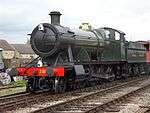 |
| No. 4270 | GWR 2-8-0T 4200 Class | Restoration from Barry Scrapyard condition completed 2014.[14] Built in 1919. Boiler ticket expires in 2024. | GWR Green, GWR Lettering | |
| No. 7903 "Foremarke Hall" | GWR 4-6-0 6959 "Modified Hall" Class | Overhaul completed in mid-2016. Built in 1949. Boiler ticket expires in 2026. | BR Green, Late Emblem | 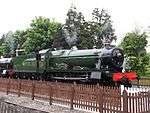 |
| No. 35006 "Peninsular & Oriental S.N. Co." | SR 4-6-2 "Merchant Navy" Class | Returned to service in mid-2016 following the completion of a 30-year restoration from scrapyard condition. Built in 1941. Boiler ticket expires in 2025. | BR Green, Late Emblem | |
| No. 7820 "Dinmore Manor" | GWR 4-6-0 7800 "Manor" Class | Returned to service in 2013 following its 10-year overhaul. The loco ran with the tender of "Dukedog" Class No. 9017 Earl of Berkeley until October 2015, when it was changed for 2884 Class No. 3850's tender after the loco came out of service for overhaul. It will soon be running with a unique Collett 3500 gallon tender. Built in 1950. Boiler ticket expires in 2023. | BR Unlined Black, Early Emblem |
Away from the GWR
| Number & Name | Description | Current Status | Livery | Image |
|---|---|---|---|---|
| No locos away at present (Nov 2016) |
Undergoing restoration, repairs or overhaul
| Number & Name | Description | Current Status | Livery | Image |
|---|---|---|---|---|
| No. 3850 | GWR 2-8-0 2884 Class | Withdrawn from traffic on 28 September 2015 and now undergoing overhaul. Owned by the Dinmore Manor Locomotive Ltd. group. | BR Unlined Black, Early Emblem |  |
| No. 2874 | GWR 2-8-0 2800 Class | Major restoration has begun. Built in 1918. Owned by the Dinmore Manor Locomotive Ltd. group. | N/A |
Stored or static
| Number & Name | Description | Current Status | Livery | Image |
|---|---|---|---|---|
| No. 76077 | BR 2-6-0 Class 4MT | Awaiting major restoration. Built in 1956. Currently stored on several flat wagons in the north siding just north of Toddington station. Restoration is hoped to begin soon. | BR Black with late crest |  |
Diesel locomotives and DMUs
Operational
| Number & Name | Description | Current Status | Livery | Image |
|---|---|---|---|---|
| No. D2182 | BR 0-6-0 Class 03 | Operational | BR green with late crest |  |
| No. 11230 | Drewry 0-6-0 Class 04 | Operational | BR black with early crest | .jpg) |
| No. D8137 | BR Bo-Bo Class 20 | Operational | BR green with full yellow front end | .jpg) |
| No. 24081 | BR Bo-Bo Class 24 | Operational | BR blue with full yellow ends | |
| No. D5343 | BR Bo-Bo Class 26 | Operational | BR blue with full yellow ends | 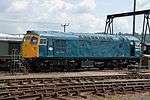 |
| No. 37215 | BR Co-Co Class 37 | Operational | BR blue with full yellow ends | |
| No. D6948 | BR Co-Co Class 37 | Operational | Original BR green | .jpg) |
| No. 45149 | BR 1 Co-Co 1 Class 45 | Operational | BR blue with full yellow ends | |
| No. 47376 "Freightliner 1995" | BR Co-Co Class 47 | Operational | Freightliner grey | |
| No. 73129 "City of Winchester" | BR Bo-Bo Class 73 | Operational | BR blue with yellow warning panels |  |
| Nos. W51405, W59510, W51363 | BR Class 117 | Operational | BR lined green with yellow warning panels | 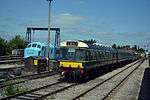 |
Non operational
| Number & Name | Description | Current Status | Livery | Image |
|---|---|---|---|---|
| No. 47105 | BR Co-Co Class 47 | Undergoing overhaul | BR blue with full yellow ends | .jpg) |
| No. 20035 | BR Bo-Bo Class 20 | Component recovery | Orange and white livery of the CFD (Compagnie de Chemins de Fer Départementaux') | |
| No. W55003 | BR Class 122 | Undergoing restoration | New livery is yet to be chosen (was BR lined green with yellow warning panels) | 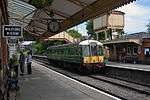 |
| No. W51360 | BR Class 117 | Undergoing restoration - has run in multiple with other 117 units | BR Blue with full yellow ends | |
| No. SC52029 | BR Class 107 | Undergoing restoration | New livery will be BR Blue with full yellow end |
Coaching stock
Operational coaches are shown in bold.
| Origin | Type | Number | Notes | Photograph |
|---|---|---|---|---|
| BR | Mk 1 RBR, | 1672, 1675 and 8805 (ex-army) | ||
| BR | Mk 1 RMB, | 1808 and 1876 | ||
| BR | Mk 1 RU, | 1965 and 1972 | ||
| BR | Mk 1 FO, | 3132 | ||
| BR | Mk 1 SO, | 4787, 4790, 4798 and 4806 | ||
| BR | Mk 1 TSO, | 3960, 4440, 4763, 4772, 4869, 4986, 5023, and 5042 | ||
| BR | Mk 1 BSOT, | 9000 | ||
| BR | Mk 1 FK, | 13326, 13329, 13337 | ||
| BR | Mk 1 CK, | 16195, 16221 | ||
| BR | Mk 1 BCK, | 21275 | ||
| BR | Mk 1 SK, | 24949, 25341, 25451, 25501, 25618, 25646 and 25743 | ||
| BR | Mk 1 BSK, | 34701, 34929, and 35308 | ||
| BR | Mk 1 Autotrailer, | 975076 | ||
| BR | Mk 1 POT, | 80432, 80434, 80411 and 80435 | ||
| BR | Mk 1 BG, | 80926, 81039, 81049, 92199, and 92418 | ||
| BR | Mk 1 TPO, | 92384 | ||
| BR | CCT, | 94486, and 94557 | ||
| BR | GUV, | 94051 |
See also
- North Gloucestershire Railway – a narrow gauge railway also at Toddington
- Stratford on Avon and Broadway Railway – a now defunct group that had initially hoped to restore the railway between Stratford upon Avon and Broadway.
References
- ↑ Railway Magazine December 1957 p. 859
- ↑ Mitchell, Vic; Smith, Keith. Stratford-upon-Avon to Cheltenham. Middleton Press. ISBN 978-1901706253.
- ↑ "GWR - Gloucestershire's mainline heritage railway - Chronology". Gloucestershire Warwickshire Steam Railway plc. 2010. Retrieved 2014-02-24.
- ↑ "GWR - Gloucestershire's mainline heritage railway - 2016 Timetable". Gloucestershire Warwickshire Steam Railway plc. 2016. Retrieved 2016-04-26.
- ↑ "Broadway Railway Station | GWSR | Broadway | Toddington |". Steaming to Broadway. 2013-03-19. Retrieved 2014-02-24.
- ↑ Bill (2014-01-21). "Steaming to Broadway!: The Broadway Signal Box". Steaming to Broadway. Retrieved 2014-02-24.
- ↑ http://broadwayextensionblog.blogspot.co.uk/2016/11/tweak-and-drop.html
- ↑ http://haylesabbeyhalt.blogspot.co.uk/
- ↑ Johnston, Howard (1–14 May 2013). "Regional News". RAIL. No. 721. p. 24.
- ↑ Scott Wilson Group. "Waitrose Development, Cheltenham". Retrieved 2010-03-09.
- ↑ Cheltenham Daily Photo (2007-12-01). "Theme Day - Bridges". Retrieved 2010-03-09.
- ↑ Development Control Sub-Committee (1997-07-08). "Redevelopment of the St.James site, Cheltenham". Gloucestershire County Council. Retrieved 2010-03-09.
- ↑ "GWR - Gloucestershire's mainline heritage railway - Honeybourne Line train services continue despite Gotherington landslip". Gloucestershire Warwickshire Steam Railway plc. 23 April 2010. Retrieved 2014-02-24.
- ↑ http://www.gwsr.com/news/latest-news/4270-steams.aspx
- Cotswold Line Promotion Group Includes proposal to link GWR to main line at Honeybourne
- About Britain Entry
- Cheltenham local attractions
- Reference in directory of Heritage Railways in the UK
- New bridge on the Honeybourne Line.
External links
| Wikimedia Commons has media related to Gloucestershire Warwickshire Railway. |
- Gloucestershire Warwickshire Steam Railway
- North Gloucestershire Narrow Gauge Railway
- Cotswold Steam Preservation Ltd. - Owners of No. 2807
- Warwickshire Railways
Coordinates: 51°59′21″N 1°55′41″W / 51.98910°N 1.92813°W